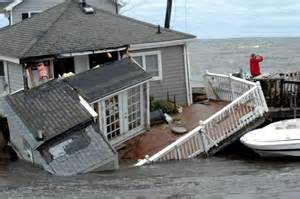On Friday Governor Dannel Malloy and UConn President Su san Herbst, along with a host of federal and state officials, announced the creation of the Institute for Community Resiliency and Climate Adaptation. Located at UConn’s Avery Point Campus, the Institute is a collaboration between UConn and CTDEEP and its mission, in broad terms, is to coordinate the state’s response to the impacts of climate change. The concept of the Institute came from the recommendations of the Legislative Shoreline Preservation Task Force, now the Climate Change and Shoreline Preservation Task Force. It has strong bipartisan support. Details of how the Institute will function will be worked out in the next few months
san Herbst, along with a host of federal and state officials, announced the creation of the Institute for Community Resiliency and Climate Adaptation. Located at UConn’s Avery Point Campus, the Institute is a collaboration between UConn and CTDEEP and its mission, in broad terms, is to coordinate the state’s response to the impacts of climate change. The concept of the Institute came from the recommendations of the Legislative Shoreline Preservation Task Force, now the Climate Change and Shoreline Preservation Task Force. It has strong bipartisan support. Details of how the Institute will function will be worked out in the next few months
Two articles and an editorial about the Institute that appeared in The Day, Southeastern Connecticut’s local newspaper, generated a combined 132 comments. A totally unscientific pre-preliminary analysis shows that the commenters generally fell into two camps. One camp is made up of those that, for identification purposes only, can be referred to as “the Deniers.” There seem to be two classes of Deniers:
1) Those who believe that climate change is a conspiracy of scientists and politicians who are trying to get rich and control the economy;
2) Those who don’t really believe in climate change but think even if it is happening, as responsible stewards of our economic future, the money should be spent on debt reduction.
Consider the comments of generalrjp (15 posts on the three news items) — “The hoax of global warming climate change continues. Radical left wingers want to believe the hoax so they can control another 1/6 of the economy with a climate tax. Climate change is the biggest man-made hoax in history” and “The facts are irrevocable and simple. Liberals want to control another 1/6 of the economy and destroy freedom. Pushing this man-made hoax is their easiest path.” Or from R (19 posts)—“Whether sea levels are rising has no bearing on the fact that the state does not have $2.5M to spend on a new project and new agency.”
In the opposite camp are those who can be referred to as “the Believers.” They also generally fall in two classes:
1) Those that believe climate scientists’ estimates of the impacts of climate change (SLR, coastal erosion, floods, drought, habitat migration, food production complications, etc.) are accurate or even a little understated.
2) Those that feel the weight of the evidence favors climate change predictions but think, even if climate scientists aren’t right, as responsible stewards of the planet, we need to take action.
A comment from Live Here (11 posts)—“That sea levels are rising and our shoreline is very vulnerable is beyond dispute. However, what the governor is instituting may not be effective unless rolled out to shoreline municipalities. In any case we should be prepared for significant land loss and increased storm intensity. This is NOT a drill.” And, from Size10 (1 post)—“Did anyone read today’s NY Times with a front page story about how Coca Cola is having to change its business strategy due to the effect on global warming on water supplies, sugar cane, sugar beets, etc.”
Deniers jumped into the commenting early and often. A quick count of the 132 comments shows 91 from people who could be classified as Deniers and 38 from Believers. The rest could be classified as neutral. An average of 27% of the total comments from each article were from Deniers before the first Believer commented. The bulk of the comments contained various facts and figures to support each of the opposing viewpoints and to rebut the other side’s viewpoints, each side accusing the other of providing false information, manipulating the numbers, etc. There were a lot of references cited and a lot of counter references. With the exception of a few comments, it was a spirited debate even if some of the “facts” lacked credibility.
It is clear that there are passionate people on both sides of the debate. The Deniers seem to be more so than the Believers. This is the climate (no pun intended) that local officials face as they begin to grapple with municipal climate change policy decisions, if they choose to do so at all. One role of the Institute will be to separate fact from fiction and provide local officials with solid information as they determine their local adaptation strategies. From addressing simple issues such as the difference between climate and weather, to demonstrating the fiscal consequences of taking a wait and see approach, there is a lot of work to do. The Institute is an investment in the future both as stewards of our financial future as well as of the environment.
For the record, I fall into the second category of believers. But my slight twinge of doubt is born from the hope that climate change isn’t really happening because of the potentially disastrous consequences. The few reservations that I do have are far outweighed by the concern over what is going to happen if the climate scientists are right. I don’t want to leave a world where my kids and grandchildren say, “How could the Baby Boomers and Generation X leave us with this mess? It was so clear what was happening and they did nothing.”